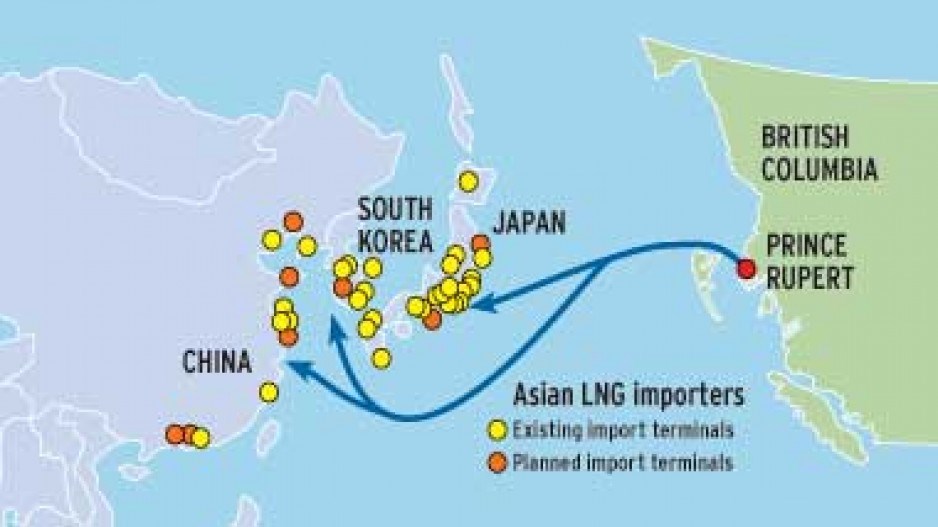Now that the B.C. government has formally backed an aggressive expansion of the province's $6.3 billion natural gas sector, the industry has opened its eyes to the next major challenge – the global race to feed liquefied natural gas (LNG) into Asia.
"Getting ahead of the competition is probably going to be difficult," said Tom Tatham, managing director of the Douglas Channel Energy Partnership. "But getting to where we get a reasonable chance of obtaining market share, that's achievable."
Tatham's project is one of a handful of LNG export terminals planned for the northwest coast that would liquefy gas from northeast B.C.'s prolific Horn River and Montney shale basins and transport it to energy-hungry customers in Japan, South Korea, Taiwan and China.
Earlier this month, Premier Christy Clark unveiled a natural gas strategy focused on developing a new LNG sector, which the government has said could produce $20 billion in new private-sector investment, more than 800 long-term jobs and up to 9,000 construction jobs.
Those are big dollars for the provincial economy, but only if the project proposals move swiftly through permitting processes and the proponents ink sales contracts with customers.
After all, B.C. isn't the only region looking to sink its teeth into the Asian market, where natural gas sells for approximately $15 per million British thermal units (MMBtu) versus an Alberta spot price of $2.06.
Colin Coe, a senior adviser for Navigant Consulting, one of North America's leading energy consultancies, said B.C.'s proximity to Asia allows it to compete with LNG suppliers from the Middle East, Australia and the Texas Gulf Coast.
"The question then becomes is there enough market demand? The North American supply is a new entrant," said Coe.
Poten & Partners, a global broker and adviser for energy companies, said in 2010 that Asia Pacific LNG demand is expected to grow 2.7% per year between 2014 and 2035.
That growth, said Poten, will "cause a supply deficit post-2015 if no additional export projects develop."
The Poten LNG market assessment (prepared for the $5.6 billion Kitimat LNG project) estimated the demand gap would grow to 130 million tonnes per year by 2035 from nine million tonnes in 2015.
"The view is that from 2015 to 2020 to 2025, you've got this systemic shortfall of supply that can't be met and that provides an opportunity for new entrants … that's the time frame that companies want to hit," said Coe.
The Douglas Channel Energy Partnership, which received an export licence from the National Energy Board this month, plans to start shipping LNG in 2014.
Meantime, Kitimat LNG, a partnership between Apache (NYSE:APA), EOG Resources (NYSE:EOG) and Encana (TSX:ECA), is targeting 2015 for its first LNG shipment (though it has yet to sign a sale contract with prospective customers).
Calgary's Progress Energy Resources (TSX:PRQ) has signed a joint venture agreement with Malaysian oil and gas giant Petronas to build a third LNG terminal in northwest B.C., and Royal Dutch Shell plc (NYSE:RDS.A) is also planning an LNG terminal in B.C. But those terminals are up against Australia, Qatar, the U.S. and other gas-producing nations.
Ben Schlesinger, a natural gas industry expert and consultant in Maryland, said in addition to B.C.'s favourable proximity to target markets, it also stands to benefit from a market diversification strategy on the part of Asia.
"So then comes North American LNG with an offer – it's going to be viewed in a fairly favourable light," said Schlesinger.
But the push for an LNG sector in B.C. is not without a hint of desperation. Advancements in horizontal drilling techniques have unlocked oceans of natural gas throughout the continent in recent years, transforming North America into a net exporter of natural gas from a net importer.
That supply glut has depressed natural gas prices on the NYMEX, forcing them as low as $2.38 per MMBtu on February 1 from a high of $4.84 last June.
And even the price last June was still barely profitable for producers in B.C., where it costs between $4 and $6 per MMBtu to extract gas from a well.
The ongoing decline in North American natural gas prices has already started to affect B.C. According to the BC Oil and Gas Commission, the number of wells drilled in B.C. last year totalled 656. That's down from 702 in 2010 and 926 in 2008.
Things aren't looking up this year either.
In January, typically the most active month for drilling, only 20 wells were drilled, down from 63 in the same month last year and 156 in 2008. With North American demand for natural gas satiated, B.C.'s industry has few options but offshore markets.
"British Columbia is in a foot race with countries such as Australia, Qatar and the United States," Energy Minister Rich Coleman said this month.
Greg Kist, vice-president marketing, corporate and government relations at Progress Energy, said the province's new strategy could do for natural gas what trade missions to China did for softwood lumber.
But what happens to B.C.'s natural gas industry if those LNG terminals aren't built?
"I think you will see a slowdown in production, a pull-back in drilling activity, a pull-back in anything related to the energy industry … you would just see a significant slow down." •




